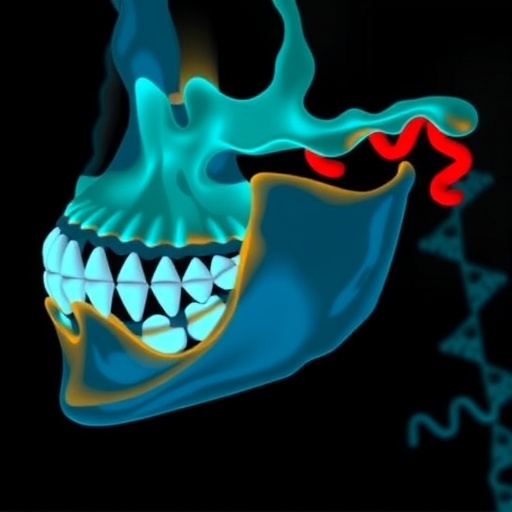In a groundbreaking study published in the International Journal of Oral Science, researchers have unveiled a pivotal molecular pathway governing the postnatal development of the mandibular condyle—a key anatomical site essential for jawbone growth and overall craniofacial architecture. The study spotlights the PLAGL1-IGF2 axis as a crucial signaling network orchestrating osteogenic differentiation and metabolic homeostasis within this specialized bone region. This discovery not only provides a new molecular framework for understanding craniofacial development but also opens promising therapeutic avenues for jaw growth disorders.
The mandibular condyle plays a fundamental role in jaw function, facilitating complex movements necessary for mastication, speech, and facial expression. Despite its clinical significance, the genetic and molecular mechanisms that regulate its postnatal ossification have remained largely unresolved due to the intricate cellular dynamics and signaling pathways involved. Professor Xinquan Jiang and his team at Shanghai Jiao Tong University sought to elucidate these mechanisms by focusing on PLAGL1, a zinc finger transcription factor inherited from the paternal allele, whose expression is integral during early cranial neural crest cell lineage differentiation.
Leveraging a lineage-specific knockout mouse model, the researchers selectively ablated Plagl1 expression in condylar progenitor cells. This targeted genetic manipulation allowed the team to dissect the functional consequences of PLAGL1 deficiency on condylar osteogenesis in vivo. Remarkably, loss of PLAGL1 disrupted the differentiation of osteoblasts—the bone-forming cells—impairing extracellular matrix synthesis and mineralization processes critical for normal bone formation. These aberrations culminated in markedly defective condylar morphology and underscored PLAGL1’s indispensable role in directing skeletal tissue maturation during postnatal jaw growth.
The mechanistic underpinnings of PLAGL1’s regulatory influence were further delineated through molecular analyses revealing its integration with the insulin-like growth factor 2 (IGF2) signaling cascade. IGF2, along with its binding proteins (IGFBPs), constitutes a vital axis controlling cellular metabolism, proliferation, and differentiation in various tissues. The study demonstrated that PLAGL1 modulates IGF2 expression and activity, with Plagl1 deletion leading to pronounced downregulation of the IGF2 pathway. This disruption was correlated with metabolic imbalances and compromised osteoblast function, thus linking transcriptional control to metabolic state and bone matrix production.
Crucially, the application of exogenous IGF2 in vitro rescued the osteoblastic defects caused by PLAGL1 loss, confirming the functional dependency of condylar osteogenesis on this ligand-receptor axis. These results establish PLAGL1 as a master regulator that governs bone formation not merely through transcriptional mechanisms but also via metabolic signaling pathways integral to cellular differentiation and tissue growth. Such findings highlight the sophisticated interplay between genetic imprinting, metabolic regulation, and skeletal development.
The research also underscores the broader significance of genomic imprinting in craniofacial biology. Imprinted genes, like PLAGL1, exhibit parent-of-origin-specific monoallelic expression, a phenomenon that ensures finely tuned dosage sensitivity during development. Aberrations in imprinting often result in congenital anomalies and growth disorders. This study positions PLAGL1 as a critical imprinting-controlled gene within the neural crest-derived osteogenic lineage, suggesting that precise epigenetic regulation is vital to maintaining jawbone integrity and function.
From a clinical perspective, the delineation of the PLAGL1-IGF2 axis furnishes a molecular basis for understanding mandibular condyle growth deficiencies, which manifest as malocclusions, asymmetries, and compromised oral functions. Targeted therapeutic strategies enhancing this signaling pathway may offer novel means to promote normal bone regeneration or correct developmental anomalies in craniofacial patients. Moreover, the study’s insights could inform tissue engineering approaches aiming to reconstruct or repair complex skeletal defects in the maxillofacial region.
Beyond immediate clinical implications, this research contributes a valuable paradigm for integrating genetic, metabolic, and cellular factors in postnatal bone development. The mouse models and molecular tools developed enable further exploration of other imprinting genes and signaling axes that may collectively govern the ontogeny of the craniofacial skeleton. Such comprehensive frameworks are essential to unraveling the multifactorial nature of skeletal disorders and devising precision medicine interventions.
Professor Jiang emphasizes that this work represents a significant advance in the molecular understanding of mandibular condyle biology. He notes, “Our findings not only reveal a previously unrecognized genetic pathway critical for postnatal jaw bone formation but also highlight the therapeutic potential of modulating the PLAGL1-IGF2 axis in craniofacial medicine.” The study invites future investigations into how this regulatory mechanism interfaces with environmental factors, mechanical loading, and other systemic signaling networks during development and repair.
This pioneering research opens exciting prospects for interdisciplinary collaboration, combining developmental biology, genetics, orthopedics, and regenerative medicine to tackle pressing challenges in oral health. As the complexity of jawbone growth becomes better understood, opportunities emerge to tailor interventions that can mitigate congenital defects and enhance recovery from trauma or disease with greater efficacy and specificity.
In conclusion, the identification of the PLAGL1-IGF2 signaling axis as a key driver of postnatal mandibular condyle osteogenesis marks a milestone in craniofacial developmental biology. This novel molecular insight advances our comprehension of the genetic and biochemical underpinnings of jaw growth and offers a foundation for new therapeutic strategies that could revolutionize the management of mandibular disorders. Continued research into this pathway and its intricate regulatory network promises to yield transformative breakthroughs in skeletal biology and reconstructive therapies.
Subject of Research: Animals
Article Title: PLAGL1-IGF2 axis regulates osteogenesis of postnatal condyle development
News Publication Date: 25-Sep-2025
Web References:
DOI: 10.1038/s41368-025-00386-4
References:
Jiang X, et al. PLAGL1-IGF2 axis regulates osteogenesis of postnatal condyle development. International Journal of Oral Science. 2025 Sep 25. DOI: 10.1038/s41368-025-00386-4.
Image Credits: Professor Xinquan Jiang, Shanghai Jiao Tong University
Keywords:
Health and medicine; Bone formation; Ossification; Tissue growth; Ontogeny; Developmental biology; Skeleton; Musculoskeletal system; Bone diseases




